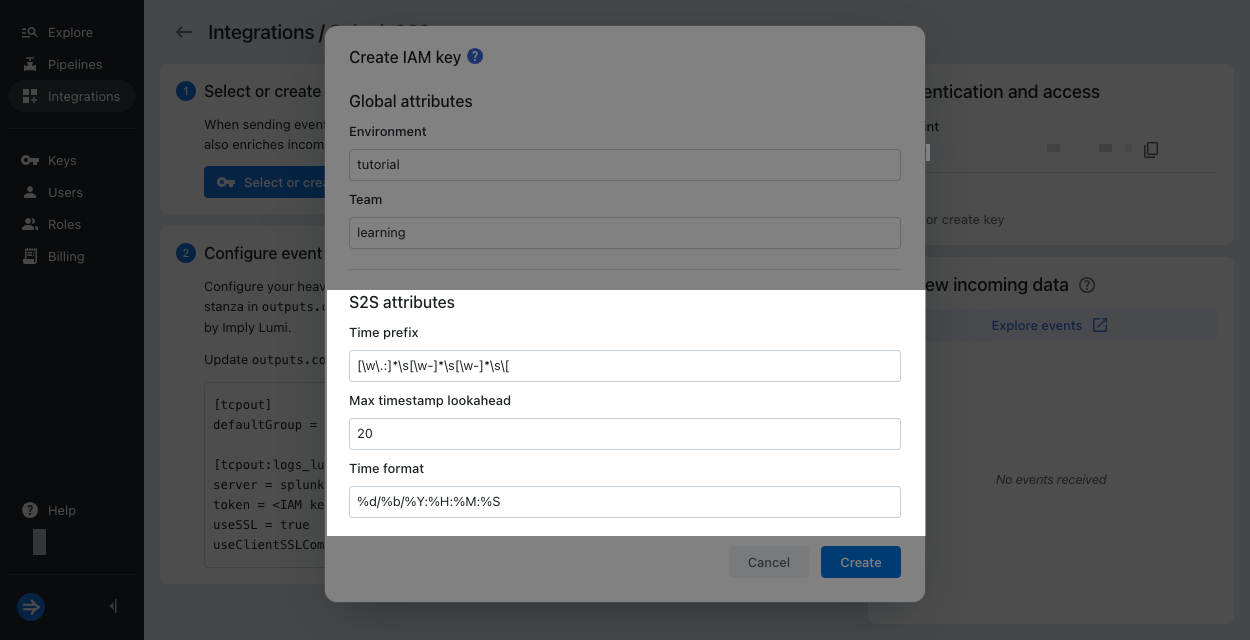Send events with S2S
AI summary
About AI summaries.
You can forward events from Splunk® universal or heavy forwarders to Imply Lumi using the Splunk-to-Splunk (S2S) data transmission protocol.
Lumi supports two S2S integrations, each corresponding to a Splunk output processor:
tcpout: Forwards data using the S2S protocol over TCPhttpout: Encapsulates the S2S payload and forwards it over HTTP
For information on the Splunk processors and their use cases, see Intermediate data routing using universal and heavy forwarders.
This topic provides details on event forwarding configuration using Splunk-to-Splunk (S2S). For an end-to-end tutorial, see How to send events with S2S.
Prerequisites
To send events to Lumi using S2S, you need the following:
-
Access to Lumi with the Data manager role or higher. For information on roles and permissions, see Manage roles.
-
Lumi IAM key. See Create an IAM key for details.
The IAM key authenticates connections to send events to Lumi. It also enriches incoming events with the system attributes for environment and team.
-
Splunk universal forwarder or heavy forwarder.
-
For the
tcpoutintegration: Port 9997 open for outbound TCP traffic on the machine forwarding the events. -
For the
httpoutintegration: Port 443 open for outbound TCP traffic on the machine forwarding the events.
S2S attributes
You define S2S attributes when you add or edit one of the S2S integrations on the key.
The IAM key attributes specify timestamp parsing configuration.
For example, you can define the format for timestamp extraction using the pattern %d/%b/%Y:%H:%M:%S.
Visit the event parsing reference for examples and additional details. Ensure that the Lumi settings match any server-side settings you have for Splunk.
Lumi doesn't store S2S attributes with events. For information on IAM key attributes, see IAM key attributes.

Configure event forwarding
This section describes how to forward events to Lumi using S2S.
It involves updating your universal or heavy forwarder outputs.conf file.
The process assumes you already have your input source and any parsing or transforms configured in Splunk.
To configure event forwarding, complete the following steps:
- From the Lumi navigation menu, click Integrations then
tcpoutorhttpout. - Select or create an IAM key.
- Assign or confirm the S2S attributes on the key.
- Copy the
tcpoutorhttpoutstanza into your forwarder'soutputs.conffile.
See the following sections for configuration information. - Restart the forwarder for the changes to take effect.
If you manage a distributed deployment, remember to deploy the new configuration to all the forwarders. Refer to the Splunk documentation for details.
To enable an S2S integration from the Keys page,
select a key and click + Add integration > S2S.
To use httpout, you need to add the integrations for both S2S and Splunk HEC.
The following sections show the configuration for each S2S integration.
S2S over TCP
Update or add the TCP output stanza in outputs.conf to include the following settings:
[tcpout]
defaultGroup = logs_lumi
[tcpout:logs_lumi]
server = LUMI_ENDPOINT
token = IAM_KEY_TOKEN
useSSL = true
useClientSSLCompression = false
Replace the variables with your own values:
LUMI_ENDPOINT: Lumi endpoint.
For example,splunk-tcp.us1.api.lumi.imply.io:9997IAM_KEY_TOKEN: IAM key token.
For example,229a2561-0000-0000-0000-bc433de16f89
You must include useSSL = true because the Lumi endpoint is SSL-enabled.
Lumi doesn't support compression, so you must also include useClientSSLCompression = false.
If you add or override additional settings in this stanza, that may impact how your data gets transmitted. In that case, Lumi may not receive your data correctly.
S2S over HTTP
Update or add the HTTP output stanza in outputs.conf to include the following settings:
[httpout]
httpEventCollectorToken = IAM_KEY_TOKEN
uri = LUMI_ENDPOINT
Replace the variables with your own values:
LUMI_ENDPOINT: Lumi endpoint.
For example,https://splunk-hec.us1.api.lumi.imply.ioIAM_KEY_TOKEN: IAM key token.
For example,229a2561-0000-0000-0000-bc433de16f89
Check Lumi for events
Once you configure event forwarding and send events, you can preview the incoming data in Lumi:
-
From the Lumi navigation menu, click Integrations, then select
tcpoutorhttpout. -
In Select or create an IAM key, select your key.
-
In Preview incoming data, view the events coming in to Lumi. Lumi automatically refreshes the preview pane to display the latest events.
-
Click Explore events to see more events associated with the IAM key. The explore view populates the search bar with your IAM key ID and the receiver type. For example:
#iamKeyId=229a2561-0000-0000-0000-bc433de16f89 #receiver=splunk.s2sAdjust the time range selector to filter the data displayed.
Once events start flowing into Lumi, you can search them. See Search events with Lumi for details on how to search and Lumi query syntax for a list of supported operators.
Learn more
See the following topics for more information:
- How to send events with S2S for a tutorial on sending events over S2S.
- Send events to Lumi for other options to send events.
- Event parsing for S2S for supported patterns to parse events.
- IAM keys attributes for a reference on IAM key attributes.
For information on the Splunk TCP output processor, refer to the following documentation: